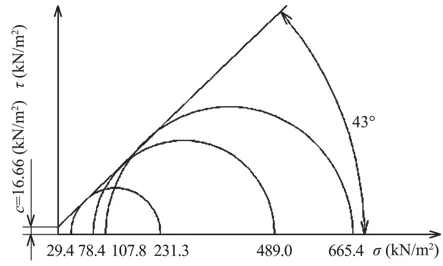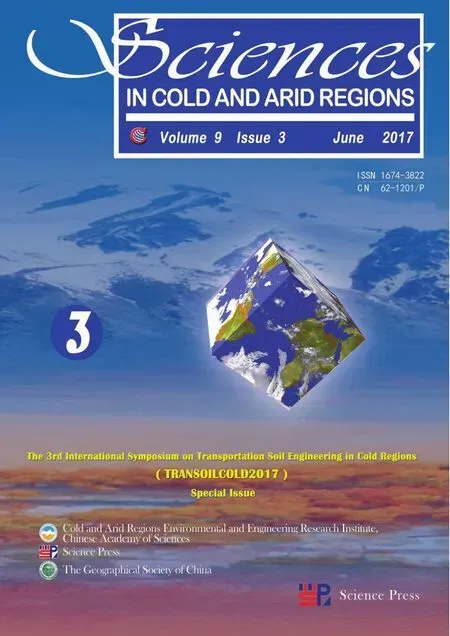Test results of railway ballast for bearing capacity calculations
Alexey F.Kolos,AnastasiaA.Konon
Emperor Alexander I St.Petersburg State Transport University,Construction of Roads for Transportation Complex Department,Moskovskiy pr.9,St.Petersburg 190031,Russia
Test results of railway ballast for bearing capacity calculations
Alexey F.Kolos,AnastasiaA.Konon*
Emperor Alexander I St.Petersburg State Transport University,Construction of Roads for Transportation Complex Department,Moskovskiy pr.9,St.Petersburg 190031,Russia
This paper presents the results of field and laboratory tests of railway ballast.Field tests were aimed to study vibrational acceleration of ballast particles and ballast layer stressed state in terms of train traffic with heavy axle loads.The test results are vibrational acceleration and stress values distribution in ballast layer and experimental relationships of vertical and horizontal vibroaccelerations damping in terms of train operation with axle load up to 300 kN.Laboratory stabilometer tests were directed to study the change of ballast strength properties due to vibrodynamic impact and shows that for dynamic loading with 10,25,55 Hz frequencies vibrodynamic impact influences strength properties insignificantly and coincides with the accuracy of test equipment.Stated test results provide references for calculation of ballast and sub-ballast bearing capacity.
ballast;vibrational acceleration;vertical stress;heavy axle load;stabilometer
1 Introduction
An important developmental area for Russian railway transport is increasing car axle load.JSCRussian Railwaysacquires cars with axle loads up to 250 kN, while future car types will have axle loads of up to 270 kN per axle.Thus,the task of track stable performance under increasing train dynamic load is vitally important.Worldwide operating experience and in-situ tests(Petryaev,2016)show that increasing axle load standards and train speed induce growth in the number of defects in ballast,subballast and subgrade (Stoyanovich and Pupatenko,2015).
Railway track stability depends not only on subgrade sustainability and quality of ties,fastenings and rails,but also on the quality of all subballast elements and the ballast itself.The main cause of ballast reliable performance is its bearing capacity which depends on the level of vibrodynamic load applied to the ballast layer(Tutulumlueret al.,2011)and subballast characteristics.Ballast layer bearing capacity and deformability depend on ballast cohesion and friction angle,moduli of deformation and elasticity.These characteristics depend on a number of factors such as vibrodynamic load level under the sleeper pad,ballast granulometric composition,fouling,density,roundness,subsleeper damper existence and its stiffness.Values of these characteristic and their change according to tonnage accumulation allow prediction of ballast bearing capacity, deformability and overhaul life.However,little attention has been paid to ballast strength and deformative properties and their change according to tonnage accumulation in terms of vibrodynamic load.Indirect methods of defining ballast strength and deformative properties are ungrounded,often uncertain and may provideinaccuratecalculation results.
2 Materials and methods
Emperor Alexander I St.Petersburg State Transport University(PGUPS)scientists held in-situ tests of vertical vibroaccelerations of ballast particles and ballast layer stressed state.These tests were held at the Russian Railway Research Institute experimental track.On site rolling stock had axle loads of 230 to 300 kN at a speed of 70 km/h.
Track structure had the following parameters:65 kg/m rails,concrete sleepers(2,000 items/km),tension clamp fastenings ARS-4,and thickness of granite ballast was 55 cm under the sleeper.Ballast consisted of 25~60 mm particles.Vertical vibroaccelerations were measured with RA 021 accelerometers. These sensors provide acceleration measurements of up to 200 m/s2and frequency of 5~5,000 Hz.Accelerometers were connected to seismic station ZET 048.Vertical stress values in ballast layer were measured with soil pressure capsule set.Sensors were placed under the sleeper and in the depth of ballast layer.Sensors were set at the sleeper end,underrail section,and near centre line of the track and up to 55 cm under the sleeper(at the sleeper end).Sensor placement in the ballast layer and subballast is presented in the Figure 1.

Figure 1 Sensor placement in the ballast layer and subballast(all measurements in meters)
Laboratorytestsinvolvedunconsolidated-undrained triaxial compression tests,held in a vacuum stabilometer(Figure 2).Tests were directed to study the change of ballast strength properties due to vibrodynamic impact.The test specimen diameter was 265 mm,and height approximately 530 mm.Specimens were made of granite and gabbro-diabase crushed stone with particle size range of 25~60 mm.Tests were made in terms of static and dynamic loading with lateral pressure 80 and 130 kPa and frequencies of 10,25 and 55 Hz.Test data included lateral and failure stresses used for drawing Mohr's circles and determination of strength properties.
3 Analysis of test results
Test results show that increasing axle load causes the rise of vibroacceleration and stress values in the ballast layer and subballast.Vertical vibroacceleration and stress distribution charts at levels of 10 and 55 cm under the sleeper pad are presented in Figures 3~6.
Analysis of test data shows that increasing of rolling stock axle loads from 225 to 294 kN/axle causes growth of vertical vibroaccelerations.Maximal values of vibroaccelerations are recorded at the underrail section,reaching from 3.8 to 9.5 g and growing 2.5x.At the sleeper end vertical vibroaccelerations are about 15%lower than at the underrail section,with amounts of 2.7 to 9 g for 225~294 kN axle load at a depth of 10 cm under the sleeper pad.The lowest values are near the track center line,which change from 2.5 to 5.7 g. Statistical analysis of test data provides the experimental relationships of vertical and horizontal vibroaccelerations damping(Kolos and Morozova,2014)in terms oftrainoperationwithaxleloadupto 300kN:

Data analysis from Figures 5 and 6 shows that car axle load primarily affects ballast and subballast stressed state.Vertical stress under the sleeper pad and ballast layer grow intensively as a result of increasing axle load.Thus,at the underrail section (point"0.76 m"in Figures 5,6)at the level of 10 cm under the sleeper pad stress became 1.5 times as much and at the level of 55 cm under the sleeper pad they increased 1.9 times due to axle load change from 230 to 300 kN.This stressed state change should be taken into account while designing ballast layer and subballast structure from the point of bearing capacity.Derived stress values are used as operating stress values in ballast and subballast strength inequality(or condition)(Kolos and Konon, 2016)(Equation(3)):

Figure 2 Stabilometer setup(left)and crushed stone unconsolidated-undrained triaxial compression tests(right)

Figure 3 Vertical vibroacceleration distribution at the level of 10 cm under the sleeper pad:1-at underrail section,2-near track center line,3-at the sleeper end

Figure 4 Vertical vibroacceleration distribution at the level of 55 cm at the sleeper end

Figure 5 Vertical stress distribution at the level of 10 cm under the sleeper pad with axle load:1-230,2-250,3-270, 4-300 kN/axle

Figure 6 Vertical stress distribution at the level of 55 cm under the sleeper pad with axle load:1-230,2-250,3-270, 4-300 kN/axle

As a result of laboratory tests,crushed stone strength properties were determined by constructing Mohr's circles.Construction is based on crushed stone stress-strain curves obtained in tests and critical stress.An example of stress-strain curve and determining of critical stress is presented in Figure 7.

Figure 7 Example of stress-strain curve for granite crushed stone for lateral pressure 130 kPa
Mohr's circles were constructed considering statistical analysis of critical stresses obtained in similar conditions for similar type and quality of specimen material(Figures 8~11).
Test data shows that for dynamic loading with 10, 25,55 Hz frequencies vibrodynamic impact influences strength properties insignificantly and coincides with accuracy of test equipment.Angle of internal friction reduction under vibrodynamic loading reached 5%for granite crushed stone and 7%for gabbro-diabase.Cohesion reduction under vibrodynamic loading totaled 6%for granite crushed stone and 9%for gabbro-diabase.These results are used in ballast bearing capacity calculations for decreasing ballast strength properties to model the vibrodynamic impact(Kolos and Konon,2016).
4 Practical problems
Obtained data and analysis results are used in calculations of ballast bearing capacity,based on ballast and subballast limiting equilibrium state(Morozova, 2014;Kolos and Konon,2016).The mentioned calculation method has to be refined using a wide range of laboratory test series:

Figure 8 Strength properties determination of granite crushed stone in terms of static loading

Figure 9 Strength properties determination of granite crushed stone in terms of dynamic loading

Figure 10 Strength properties determination of gabbrodiabase crushed stone in terms of static loading

Figure 11 Strength properties determination of gabbrodia-base crushed stone in terms of dynamic loading
-research of vibrodynamic load impact on ballast strength characteristics(cohesion,friction angle,moduli of deformation and elasticity);
-research of relationships between ballast strength and deformability characteristics and its density,humidity,fouling,and accumulated tonnage;
-effect detection of mixing new and cleaned ballast on ballast mechanical characteristics;
-research of ballast deformability in terms of cyclic loadingdependingondensity,humidity,andfouling.
Using laboratory tests results and the stated mathematical model,bearing capacity dependence on the operating parameters can be derived,such as accumulated tonnage,speed,and axle load.This complex research will help solve scientific and practical problems of ballast bearing capacity,deformability and overhaul life and optimize track reliability costs.
5 Conclusions
Field test data shows that increasing of rolling stock axle loads from 225 to 294 kN/axle causes growth of vertical vibroacceleration and stress.Maximal values of vibroacceleration and stress are recorded at the underrail section.At the sleeper end vertical vibroaccelerations are about 15%lower.Experimental relationships of vertical and horizontal vibroaccelerations damping in terms of train operation with axle load up to 300 kN were derived(Equations(1)and(2)).Vertical stress under the sleeper pad and ballast layer grow intensively as a result of increasing axle load.Thus,at the underrail section(Figures 4,5)at the level of 10 cm under the sleeper pad,stress became 1.5 times as much and at the level of 55 cm under the sleeper pad they increased 1.9 times.
Laboratory tests of crushed stone strength propertiesshowthatvibrodynamicimpactinfluences strength properties insignificantly and coincides with accuracy of test equipment.Angle of internal friction reduction under vibrodynamic loading reached 5% for granite crushed stone and 7%for gabbro-diabase. Cohesion reduction under vibrodynamic loading totaled 6%for granite crushed stone and 9%for gabbrodiabase.These results are used in ballast bearing capacity calculations for decreasing ballast strength properties to model the vibrodynamic impact.
Kolos A,Morozova A,2014.Distribution survey for vibrational acceleration of ballast particles under condition of train traffic with increased axial loads.Proceedings of Petersburg Transport University,2(39):29−35.
Kolos A,Konon A,2016.Estimation of railway ballast and subballast bearing capacity in terms of 300 kN axle load train operation.In:Askar Zhussupbekov(ed.).Challenges and Innovations in Geotechnics.Proceedings International Conference,Astana,5~7August 2016.Rotterdam:Balkema.
Morozova A,2014.Ballast and subballast bearing capacity at railway lines with 300 kN car axle load.Candidate of Engineering Science Thesis,Petersburg State Transport University,pp.184.
Petriaev A,2016.The vibration impact of heavy freight train on the roadbed.In:Correia AG(ed.).Advances in Transportation GeotechnicsⅢ/Procedia Engineering,143:1136−1142.
Stoyanovich GM,Pupatenko VV,2015.Propagation of vibrations in thawing deep seasonally frozen soils in railway subgrade.Sciences in Cold and Arid Regions,7(5):534−540.
Tutulumluer E,Qian Y,Hashash YYMA,et al.,2011.Field validated discrete element model for railroad ballast.In:Proceedings of the American Railway Engineering and Maintenance-of-Way Association Annual Conference,Minneapolis,MN,September 2011.https://www.arema.org/proceedings/proceedings_2011.aspx
:Kolos AF,Konon AA,2017.Test results of railway ballast for bearing capacity calculations.Sciences in Cold and Arid Regions,9 (3):0312-0316.
10.3724/SP.J.1226.2017.00312.
November 15,2016Accepted:December 15,2016
*Corresponding author:Ph.D.,Anastasia A.Konon,Emperor Alexander I St.Petersburg State Transport University,Moskovskiy pr.9,St.Petersburg 190031,Russia.Tel:+7-921-7955857;E-mail:a.a.konon@mail.ru
 Sciences in Cold and Arid Regions2017年3期
Sciences in Cold and Arid Regions2017年3期
- Sciences in Cold and Arid Regions的其它文章
- Complex analysis of the damage caused by geocryologic processes (as exemplified by effects on the Chara-China Railway track, Transbaikal region)
- Geotechnical problems on freezing ground soil and experimental investigation in Kazakhstan
- Freezing characteristics of a highway subgrade
- Technological risk regulation of the subgrade base stability in permafrost areas
- Strengthening long-term embankments maintained on permafrost soils
- Deformation properties of chloride saline soil under actionofalow-temperatureenvironmentanddifferentloads
